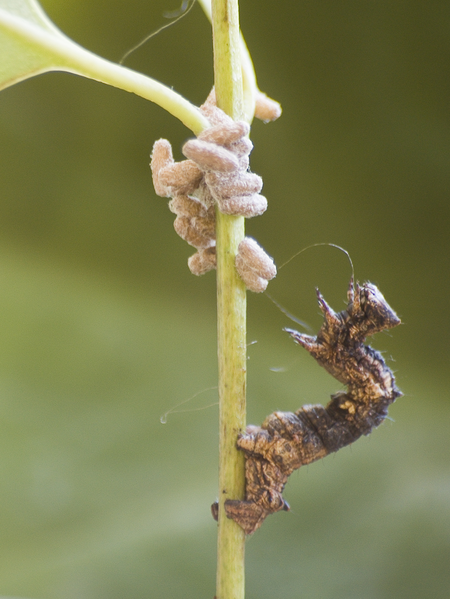When a fertile Glyptapanteles wasp is about to lay her eggs, she seeks out a caterpillar. While it is unknown if the wasp can parasitize any species, it is know to seek out at least three specific species: Lymantria dispar, the Gypsy Moth; Chrysodeixis chalcites, the Golden Twin Spot Tomato Looper; and Thyrinteina leucocerae, the Geometrid Moth. Upon finding one of these caterpillars, she stings it, injecting a paralyzing venom to keep her subject still. This is key as the wasp will then stab the caterpillar with her ovipositor and then proceeds to lay up to 80 eggs inside the caterpillar's body. Once this is finished, the wasp simply flies off leaving the caterpillar to slowly recover.
For a while the caterpillar goes back to its life of constant eating, probably wishing the previous events were just a horrible nightmare or a case of sleep paralysis. Unfortunately for our surprisingly self aware caterpillar, it did really occur and those eggs soon hatch and the larvae begin gorging on the insides of their warm squishy home. They don't go so far as to kill the caterpillar as they have need of it for later.
Eventually the larvae are are ready to pupate, but they must first exit their home/buffet. So they begin the process of eating their way out of the now somewhat hollowed caterpillar. They then spin their cocoons nearby. If evolution were merciful, the caterpillar would now be able to know the sweet embrace of death. Instead, the caterpillar actually heals its wounds and remains alive, though it is left in a somewhat altered state. It loses all interest in eating and instead focuses on the cocoons, spinning extra protective webbing around them and even charging and attacking any insect that gets to close. Why would it protect its former tormentors? The reason wasn't certain for quite a while until it was noted that some of the larvae don't leave their host. These larvae instead sacrifice themselves for the good of the many by taking control of the behavior of the caterpillar.
I'm sure you never thought you could say that you have seen a zombie caterpillar, did you?
Eventually, adult wasps emerge from their chrysalides and fly off. The caterpillar turned zombie guard dog is left to slowly starve, still watching over the empty shells.


5 comments:
In its hideous way, it's a marvelous example of Dawkins's concept of the extended phenotype. Genes are controlling the caterpillar to ensure their own perpetuation -- they just aren't the caterpillar's own genes.
there is no way a benevolent deity could create something like this.
We're fortunate that evolution didn't drive the point home by producing a parasitically-reproducing organism large enough to exploit humans in such a fashion (this is where the idea for the movie Alien came from).
you are quite right, I've often marveled at nature for the various ways that genes have found ways to propagate themselves.
Even in the most disturbing cases there is almost a beauty in the ingenuity. It is this constant variation to the extremes that has drawn me to the biological sciences for so long.
I assume you read about this on www.toptenz.net because you are using an image from our site and our bandwidth to display it. It would be the right thing to do to give us credit. I assume you are a faithful reader and would like us to stick around. Sending us visitors helps us keep it going every week. Thanks for your help.
Actually I had found out about it through the book Parasite Rex, by Carl Zimmer. I needed an image and yours was what I found. However if needed, I shall grab it elsewhere. I'm sorry for the confustion
Wow! That was fascinating! Life in all it's forms and complexities never ceases to amaze. In fact it's humbling.
Post a Comment